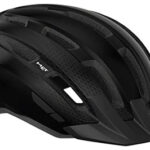Choosing the right mountain bike size is crucial for comfort, performance, and safety on the trails. Unlike road bikes, mountain bike sizing can be a bit more nuanced, often using Small/Medium/Large designations instead of direct inch measurements. Modern mountain bike geometries have evolved significantly, making traditional frame measurements less reliable. This guide and Bike Size Chart will help you navigate the sizing process and find the perfect mountain bike for your adventures.
| Frame Size | Frame Size (Inches) | Rider Height Range | Inseam Range | Suggested Wheel Size |
|---|---|---|---|---|
| XS | 13.5″ | 4’5.9″ – 5’1.0″ (137.0 – 155.0 cm) | 25.2″ – 28.7″ (64.0 – 73.0 cm) | 26″ or 27.5″ |
| S | 15.5″ | 5’0.2″ – 5’5.6″ (153.0 – 166.5 cm) | 28.3″ – 31.1″ (72.0 – 79.0 cm) | 27.5″ or 29″ |
| M | 17.5″ | 5’3.4″ – 5’7.7″ (161.0 – 172.0 cm) | 29.9″ – 31.9″ (76.0 – 81.0 cm) | 27.5″ or 29″ |
| M/L | 18.5″ | 5’5.2″ – 5’10.5″ (165.5 – 179.0 cm) | 30.3″ – 33.1″ (77.0 – 84.0 cm) | 29″ or 27.5″ |
| L | 19.5″ | 5’9.7″ – 6’2.0″ (177.0 – 188.0 cm) | 32.7″ – 34.6″ (83.0 – 88.0 cm) | 29″ or 27.5″ |
| XL | 21.5″ | 6’1.2″ – 6’5.2″ (186.0 – 196.0 cm) | 34.3″ – 36.2″ (87.0 – 92.0 cm) | 29″ or 27.5″ |
| XXL | 23.0″ | 6’4.8″ – 6’7.9″ (195.0 – 203.0 cm) | 36.2″ – 37.4″ (92.0 – 95.0 cm) | 29″ or 27.5″ |
Shop Mountain Bikes
Matching Wheel Size to Your Mountain Bike and Height
When considering mountain bike wheel size alongside frame size, your height and riding style are key factors. While smaller riders sometimes feel more comfortable with smaller wheels, the optimal choice depends on experience level and desired riding characteristics.
For beginners, sticking with the first suggested wheel size in the bike size chart is generally recommended. More experienced riders might explore the alternative wheel size option, considering how each size impacts handling and performance.
Larger wheels (29″) offer benefits like faster top speeds and improved rollover capability on rough terrain. They maintain momentum better and are generally more efficient for covering ground. Smaller wheels (27.5″ or 26″) are often more agile and responsive, making them popular for tighter trails and riders who prioritize maneuverability and playfulness. If speed and efficiency are paramount, larger wheels are a strong choice. If agility and a lively feel are preferred, smaller wheels might be more enjoyable.
Bike manufacturers like Trek often advise riders to choose the largest wheel size they can comfortably manage. To truly understand what feels best, test riding different wheel sizes is highly recommended. Visiting your local bike shop for a test ride provides invaluable insight.
Sizing Up or Down: Mountain Bike Fit Considerations
If you find yourself between sizes on a mountain bike size chart, deciding whether to size up or down depends on your riding preferences and body proportions. Consider these points when making your choice:
Reasons to Size Up Your Mountain Bike:
- Aggressive Riding Style: Aggressive riders often prefer a longer reach for enhanced stability at high speeds and on steep descents.
- Downhill Stability: Larger frames generally offer more stability when descending technical trails.
- Obstacle Rollover: If you prefer to power over obstacles rather than weave around them, a larger bike can provide a more stable platform.
- Longer Wingspan: Riders with a wingspan greater than their height may find a larger frame more comfortable.
- Flexibility and Adaptability: If you are flexible and skilled at adjusting your body position to navigate varied terrain, a slightly larger frame can offer advantages.
Reasons to Size Down Your Mountain Bike:
- Upright Riding Position: If you prefer a more upright and less stretched-out riding posture, a smaller frame is often better.
- Conservative Riding Style: Riders with a more cautious or less aggressive style might find a smaller, more maneuverable bike more confidence-inspiring.
- Maneuverability Focus: For riders who prioritize quick handling and agility on tight, twisty trails, a smaller frame is typically more responsive.
- Limited Flexibility: Less flexible riders might find a smaller frame more comfortable and easier to manage.
- Preference for Playfulness: Smaller bikes are often perceived as more playful and easier to handle for jumps and tricks.
Brand-Specific Mountain Bike Sizing and Variations
It’s essential to recognize that mountain bike sizing isn’t uniform across all brands. Some manufacturers simplify their sizing with numerical systems (e.g., 1-6) instead of XS-XL. Always consult the specific size chart provided by the bike brand you are considering. Additionally, reviewing the bike’s geometry chart offers detailed measurements like reach and stack, which can further refine your size selection.
The Evolution of Mountain Bike Sizing
Historically, mountain bike sizes were primarily determined by seat tube length. This measurement provided a reasonable estimate of standover height when frame designs were simpler and more akin to road bikes.
However, as mountain bike technology advanced, frame geometries became more complex to enhance performance. Features like longer top tubes, slacker head angles, and dropper post compatibility became common. These design shifts made seat tube length a less accurate indicator of overall bike size and fit. This evolution prompted brands to develop their own sizing methodologies to better reflect the fit and feel of modern mountain bikes. Understanding these changes highlights why relying solely on seat tube measurements is no longer sufficient and emphasizes the importance of using comprehensive bike size charts and geometry information.


